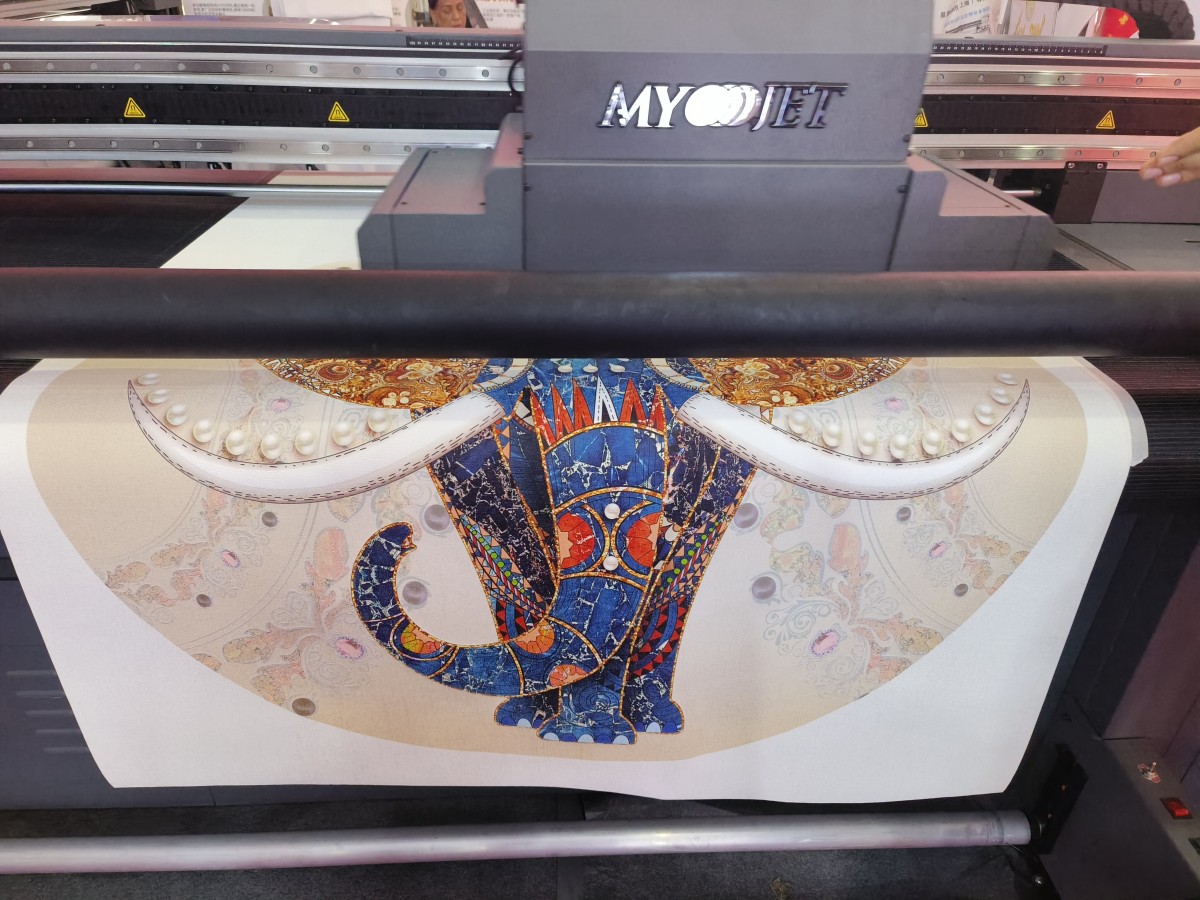UV printing, as an innovative technology in the modern digital printing field, is gradually replacing many traditional printing methods. It not only improves production efficiency but also showcases unique advantages in terms of environmental friendliness, adaptability, and print quality. In various sectors such as advertising, packaging printing, home decoration, and industrial products, UV printing has become the preferred choice for many businesses. This article will delve into the working principle of UV printing, its differences from traditional printing, main characteristics, and application fields, helping you understand the ultimate advantages of UV printing and its potential for future development in the printing industry.
1. What is UV Printing?
UV printing is a digital inkjet printing method based on ultraviolet (UV) light curing technology. Its core working principle involves spraying UV ink onto the substrate surface using print heads and instantly curing the ink with UV light. Unlike traditional printing methods, UV ink does not permeate the material but forms a cured image layer directly on the surface. This technology allows UV printing to be applied to almost all materials, including paper, plastic, metal, glass, and wood.
The UV printing process can be divided into the following steps:
Pre-treatment: Before printing, a series of treatments are necessary for the printing materials to achieve better quality. These treatments may include cutting, stamping, sanding, cleaning, applying adhesives, and surface coating for low-adhesion materials (like glass and tiles) to enhance ink adhesion.
Printing: Using a UV printer to print. In this process, digital printing technology is employed to input the designed image through graphic software and then print it.
Coating (optional): For certain materials or design requirements, a coating may be needed post-printing. This can protect the printed image, making it more durable, and can add special agents to enhance the surface's appearance, smoothness, and features like water and UV resistance.
Drying: The final main step is drying. The UV printer uses UV curing technology to rapidly dry the printed image, avoiding the long waiting time required in traditional water-based printing, thus improving print quality.
In practice, there may also be additional steps such as pre-checks, preparing print files, setting parameters, positioning, and calibrating to ensure smooth operation and high-quality results.
2. Differences Between UV Printing and Traditional Printing
In the printing industry, traditional methods mainly include offset printing, gravure printing, screen printing, and heat transfer printing. While widely used in various advertising and industrial production, these traditional methods have significant limitations. In contrast, UV printing technology compensates for these shortcomings with its unique advantages. Here are the key differences between UV printing and traditional printing methods:
Ink Curing Method: Traditional printing primarily relies on natural drying or heating for ink curing, while UV printing uses UV light for curing. UV ink can cure instantly under UV light, greatly enhancing production efficiency and avoiding blurriness or ink bleed issues common in traditional printing.
Material Compatibility: Traditional methods are often limited to specific materials; for example, offset printing is mainly for paper, while screen printing is used for fabrics or plastics. UV printing can print on almost any material, making it an ideal choice for diverse printing needs.
Environmental and Safety Aspects: Traditional printing, especially solvent-based, often releases large amounts of volatile organic compounds (VOCs), posing risks to health and the environment. UV printing uses eco-friendly materials that produce no harmful gases during curing, significantly reducing ink waste and aligning with current green manufacturing standards.
Image Quality and Resolution: Traditional printing technology is mechanically constrained, making it difficult to achieve ultra-high precision. In contrast, UV printing devices can achieve high resolutions, producing intricate patterns and rich color gradients, typically reaching resolutions of 1440 dpi or higher.
Instant Drying, Time-Saving: Traditional methods usually require long drying times, especially for large-format prints. UV printing's "instant spray and dry" feature allows for immediate post-processing, significantly enhancing production efficiency, especially for high-volume production needs.
Personalization and Customization Capability: Traditional printing often relies on templates or plates, complicating the production process and making personalization difficult. As a digital printing technology, UV printing allows direct output from a computer without the need for templates, making it ideal for customized, small-batch production.
Advantages
The advantages of UV printing primarily include:
- Wide Material Compatibility: Almost all materials can be printed on, providing greater options and possibilities.
- Instant Curing: No waiting for drying time after printing, significantly increasing production efficiency.
- High Resolution and Quality: Capable of producing intricate designs and clear text with vivid colors.
- Eco-Friendly: The inks used meet national quality standards, reducing environmental pollution.
Durability and Weather Resistance: Printed images are durable and can maintain vibrant colors and quality in both indoor and outdoor environments. For example, our MYJET-1860PRO-UV machine utilizes white ink stacking technology to create a 3D relief painting effect, which has received strong recognition and encouragement from exhibition customers, boosting our confidence to improve further.

In summary, UV printing has significant advantages in curing methods, material adaptability, environmental friendliness, and printing effects, while traditional printing holds unique benefits in cost and mass production. When choosing a printing technology, one must weigh the pros and cons based on specific needs.
3. Main Features of UV Printing
UV printing not only surpasses traditional printing in efficiency but also possesses a series of unique advantages. Here are the main features of UV printing:
Multi-Material Compatibility: UV printing can be performed on various materials, such as paper, plastic, metal, glass, ceramics, and wood, with strong adhesion and durability of printed images, suitable for advertising signs, packaging, home decoration, and industrial product customization.
Eco-Friendly and Low Energy Consumption: Due to the use of eco-friendly UV inks, UV printing does not produce harmful substances during curing, meeting current environmental regulations. Additionally, UV printing equipment is energy-efficient, which can effectively reduce operational costs in the long run.
Rapid Curing, High Efficiency: The ink curing process in UV printing is extremely fast, usually completed within milliseconds. This greatly shortens production cycles compared to traditional methods, improving overall production efficiency.
High Resolution and Color Reproduction: UV printing equipment supports high-resolution output, clearly showcasing complex images and details, especially in high-precision design contexts, such as display graphics, advertising images, and crafts.
Strong Durability: Images generated by UV printing exhibit excellent weather resistance, are less likely to fade or peel, and are scratch-resistant and waterproof. This makes UV printing particularly suitable for outdoor advertising and vehicle wraps.
4. Application Fields of UV Printing
With its multifunctionality and flexibility, UV printing technology has been widely applied across multiple industries. Here are some major application fields:
Advertising and Signage: UV printing is extensively used in the advertising industry, especially for outdoor advertising, lightbox cloths, and vehicle decals. The vibrant colors and strong durability of UV-printed images can withstand outdoor conditions without fading or deforming, meeting the high demands for quality and weather resistance.
Packaging and Labels: In the packaging printing sector, UV printing has become the ideal choice for high-end packaging due to its eco-friendliness and speed. Whether for plastic bags, cardboard boxes, metal cans, or glass bottles, UV printing can achieve high-quality print effects, enhancing the visual appeal of packaging.
Home Decoration: UV printing is widely used in home decoration, enabling exquisite designs to be printed on materials like tiles, glass, and wood for wall decoration and furniture design. It allows for personalized customization while ensuring durability and longevity, making it perfect for unique home designs.
Industrial Product Customization: In the industrial field, UV printing technology is gradually being applied to product design and customization, such as electronic product casings, metal parts, and automotive components, meeting the manufacturing needs for product appearance and brand promotion.
5. Future Development Trends
As an advanced digital printing technology, UV printing will continue to evolve towards greater intelligence, environmental sustainability, and efficiency. With ongoing technological advancements, the application fields of UV printing will expand further, becoming a significant force driving the development of the modern printing industry. Here are some future trends for UV printing:
Intelligent and Automated: With the advancement of Industry 4.0, UV printing equipment will gradually achieve intelligence and automation. Future UV printers will automatically adjust parameters, monitor device status in real time, and even integrate with AI for smarter image processing.
High Resolution and Fast Printing: To meet market demands for high quality and efficiency, future UV printing equipment will continually enhance resolution and printing speed. Next-generation UV printers will complete large-format, high-precision printing tasks in a short time, further improving production efficiency.
Environmental Sustainability: The rising awareness of environmental protection will drive the green development of UV printing technology. UV printers and inks will focus more on eco-friendliness, using low-VOC emissions, low energy consumption, and low-pollution materials and technologies to comply with regulations and meet consumer demand for green products.
Personalization and Customization: With increasing consumer demand for personalized products, UV printing technology will play a more significant role in customization. UV printers can quickly and flexibly print various personalized designs and logos, meeting consumer preferences for product appearance.
Technological Innovation and Performance Improvement: With continuous technological progress, the performance of UV printers will be further enhanced. Key indicators like printing speed, resolution, and color reproduction will be continually optimized to meet market demands for high-quality and efficient printing. Additionally, UV ink technology will innovate to develop more eco-friendly, wear-resistant, and weather-resistant ink products suitable for various applications.
Expansion of Application Fields: UV printers have been widely used in advertising, decoration, industrial manufacturing, and electronic product labeling. In the future, new application fields such as medical devices, automotive parts, and construction materials will continue to expand, aligning with the durability and environmental adaptability of UV printing technology.
6. Conclusion
With its environmental friendliness, efficiency, and wide adaptability, UV printing technology is gradually replacing traditional printing methods and becoming a vital force in the modern printing industry. Its multifunctionality and high-quality output provide new business opportunities for various sectors, including advertising, packaging, and home decoration. If you are considering an efficient and eco-friendly UV printing device for your business, our UV printers, capable of handling various materials—including curved surfaces—are easy to operate and maintain, making them your ideal choice.
GET IN TOUCH

